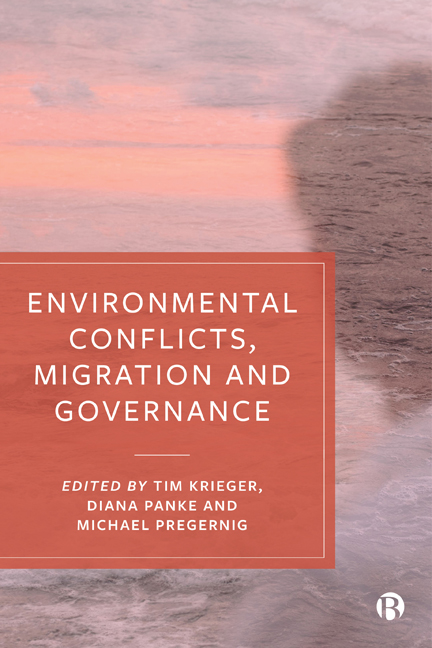Book contents
- Frontmatter
- Contents
- List of Figures and Tables
- List of Acronyms
- Notes on Contributors
- Acknowledgements
- 1 Environmental and Resource-Related Conflicts, Migration and Governance
- 2 Renewable Resource Scarcity, Conflicts and Migration
- 3 Extractive Resources, Conflicts and Migration
- 4 Climate Change, Conflicts and Migration
- 5 The Individual Level: Selection Effects
- 6 The Individual Level: Sorting Effects
- 7 Migration Governance at the State Level: Policy Developments and Effects
- 8 Environmental Migration Governance at the Regional Level
- 9 Migration Governance at the Global Level: Intergovernmental Organizations and Environmental Change-Induced Migration
- 10 The Link between Forced Migration and Conflict
- 11 Conflict-Prone Minerals, Forced Migration and Norm Dynamics in the Kimberley Process and ICGLR
- 12 On the Nexus Between Environmental Conflict, Migration and Governance: Concluding Remarks
- Index
2 - Renewable Resource Scarcity, Conflicts and Migration
- Frontmatter
- Contents
- List of Figures and Tables
- List of Acronyms
- Notes on Contributors
- Acknowledgements
- 1 Environmental and Resource-Related Conflicts, Migration and Governance
- 2 Renewable Resource Scarcity, Conflicts and Migration
- 3 Extractive Resources, Conflicts and Migration
- 4 Climate Change, Conflicts and Migration
- 5 The Individual Level: Selection Effects
- 6 The Individual Level: Sorting Effects
- 7 Migration Governance at the State Level: Policy Developments and Effects
- 8 Environmental Migration Governance at the Regional Level
- 9 Migration Governance at the Global Level: Intergovernmental Organizations and Environmental Change-Induced Migration
- 10 The Link between Forced Migration and Conflict
- 11 Conflict-Prone Minerals, Forced Migration and Norm Dynamics in the Kimberley Process and ICGLR
- 12 On the Nexus Between Environmental Conflict, Migration and Governance: Concluding Remarks
- Index
Summary
Introduction
Renewable resources such as water, soil and forests regenerate after extraction. The day when human consumption exceeds global nature's regeneration capacity in a given year is called ‘earth overshoot day’. In an ideal world, this day would be on 31 December of the same year or later. In the year 2000, however, earth overshoot day was on 23 September, and ten years later, humanity's annual budget of renewable resource use had already expired on 9 August. The 2018 earth overshoot day was on 1 August (Earth Overshoot Day Network, 2018).
This indicator is, of course, broad, but it demonstrates that the world's renewable resources face some worrisome degradation trends. As illustrated by Figure 2.1, the amount of arable land and available freshwater resources per capita, and the global forest area, have all been in decline in the past 25 years. The main drivers of this increasing resource scarcity are rising levels of consumption (especially by the developed countries and emerging global middle classes) and population growth. Unequal access to natural resources (and related services) further plays a role by allowing for excessive overconsumption of the haves and by stimulating desperate overextraction by the havenots. Climate change, itself a product of human-induced CO2 releases into the earth's atmosphere (see Figure 2.1), will further aggravate the situation, for instance, due to more frequent droughts and a rising sea level (see Chapter 4).
In the face of growing worldwide scarcity, access to renewable resources remains highly unequal within and between states. This is due to a number of factors. First, climatological, physical and geographical factors cause an unequal distribution of natural resources. Canada, for instance, has much more renewable freshwater (2.850 billion cubic metres) per year than Libya (one billion cubic metres). Second, some countries and regions are more effective (though not necessarily more sustainable) in managing their existing resources, for instance through dams, land-use planning, groundwater exploitation and demand management. Third, purchasing power is an important determinant of resource access. Rich states can import virtual water and land in the form of food or desalinate sea water, while poor ones have more difficulties in doing so.
- Type
- Chapter
- Information
- Environmental Conflicts, Migration and Governance , pp. 17 - 36Publisher: Bristol University PressPrint publication year: 2020



